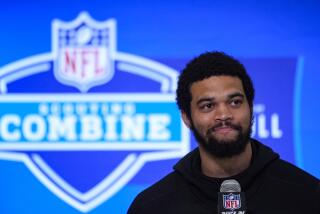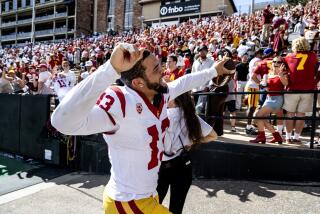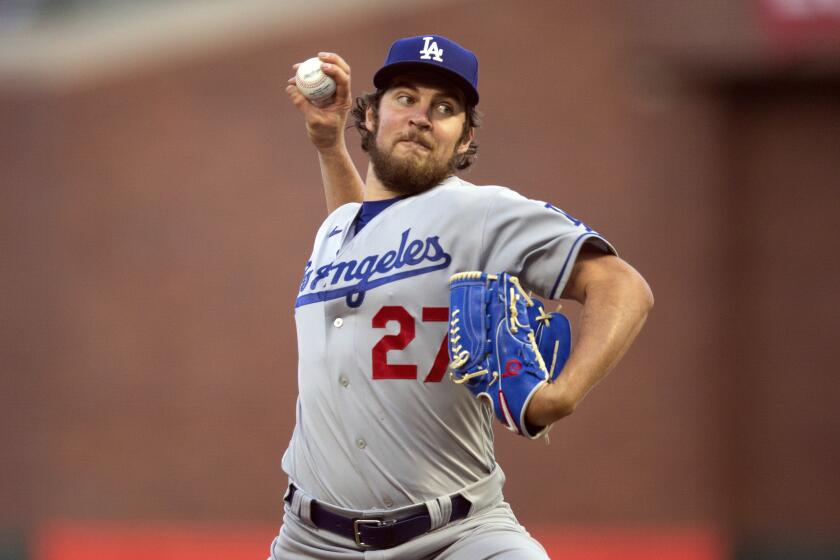NFL draft: Even zero-star prospects become first-round picks
With the first selection in the 2018 NFL draft, the Cleveland Browns took Baker Mayfield. He was a three-star player after his senior year in high school.
The second quarterback chosen was USC’s Sam Darnold, a four-star player. The third quarterback chosen was Wyoming’s Josh Allen, a two-star player.
It wasn’t until Arizona drafted UCLA’s Josh Rosen 10th overall that a five-star quarterback was chosen. He also was the first five-star player at any position chosen.
The fifth quarterback chosen in the first round, Louisville’s Lamar Jackson, was a three-star player.
With the star system used by 247 Sports — a compilation of their ratings of high school seniors as well as those on sites such as ESPN, Rivals and Scout — there were seven players with five stars chosen in the first round, nine with four stars, 12 with three stars, two with two stars and two with zero stars. (There were no one-stars.)
How do we read the stars?
Bobby Burton, one of 247’s navigators, explained this week that five-star players are projected as future first-round draft choices, four stars as NFL players, three stars as potential NFL players and two stars as, well, accomplished enough to at least have stars in their eyes.
Considering scouts for various sites are trying to determine how 17- and 18-year-old players will develop over the next three to five years — using film, interviews with high school coaches, interest from college recruiters, camps, combines and all-star games to collect data — it is an inexact science.
“It’s about which players have special talent who will work hard enough in college to stay at that level,” Burton said. “It’s also about which players are likely to become special talents. There’s an art to figuring that out. You’re going to have hits and misses.”
Of 32 first-round draft choices, 28 had at least three stars. That’s a lot of hits.
In the 2017 draft, seven of the top 12 players chosen had four or five stars. Myles Garrett was 247’s No. 1 player going into college at Texas A&M. After three seasons, he was the No. 1 player chosen in the draft. Leonard Fournette was that class’ No. 2 player going into Louisiana State and was chosen fourth overall in 2017.
“There are 10,000 high school football players to evaluate,” Burton said. “I think we do pretty well.”
But about those misses … there are more five-star players who don’t make it to the NFL than do. Reasons include injuries, coaching changes, bad behavior and poor academics. As a cautionary note to college football fans, just because your team has recruited a lot of five-star athletes doesn’t necessarily mean they’re going to be all-stars.
The No. 1 player in the class of 2015 was Trenton Thompson, a defensive tackle from Albany, Ga., who went to Georgia. Some scouts compared him to Ndamukong Suh. Although Thompson didn’t meet the high expectations, he declared for the draft. He wasn’t taken last week and signed a free-agent contract with Cleveland.
It’s too soon to judge that class of five-star players because so many of the 32 are still in school. Of those who did make themselves eligible for the draft, first-rounders were Rosen, Alabama wide receiver Calvin Ridley and Florida State safety Derwin James.
More intriguing were the two players — Allen and Marcus Davenport who had two stars — and the two players — Leighton Vander Esch and Hayden Hurst — who had zero.
Davenport, a defensive end selected 14th overall by New Orleans, was barely recruited out of a San Antonio, Texas high school, eventually choosing Texas San Antonio over Nevada Las Vegas. He had 55 tackles and 8½ sacks in 2017 and was named Conference USA defensive player of the year.
Hurst, a 24-year-old tight end chosen 25th overall by Baltimore, took himself out of the running for football stars by deciding to concentrate solely on baseball as a high school senior in Jacksonville, Fla.
The Pittsburgh Pirates drafted him in the 17th round in 2012, earning him a signing bonus of $400,000. But he developed the yips — known among Dodgers fans as “Steve Sax Syndrome” — on the mound during a game in his second season, ending his pitching career. He returned to football, playing at South Carolina, and had 100 catches for 1,281 yards in three seasons, earning All-SEC honors in 2017.
Allen and Vander Esch took parallel routes to the NFL. Both grew up in small towns: Allen in Firebaugh, about 40 miles west of Fresno, and Vander Esch in Riggins, Idaho.
Allen didn’t receive any Division I scholarship offers from FBS or FBC schools despite his own mass email campaign. Even after a record-setting season at a nearby community college, Reedley, he received offers only from Eastern Michigan and Wyoming, and Eastern Michigan withdrew its offer. He threw for 5,066 yards and 44 touchdowns in a little more than two seasons at Wyoming. Buffalo made him the seventh overall pick in the draft.
Vander Esch’s hometown was even smaller. There were 11 students in his high school graduating class. The school didn’t have enough players for 11-man football, playing eight-man. Like Allen, he advocated for himself, sending out 16-minute highlight films to colleges. With no offers, he walked on as a linebacker at Boise State. He made 141 tackles in 2017 was named the Mountain West Conference defensive player of the year. Dallas made him the 19th overall pick in the draft.
As a note of encouragement to high school players, no stars doesn’t mean you won’t become one.
More to Read
Get our high school sports newsletter
Prep Rally is devoted to the SoCal high school sports experience, bringing you scores, stories and a behind-the-scenes look at what makes prep sports so popular.
You may occasionally receive promotional content from the Los Angeles Times.






